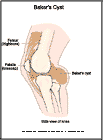
Baker's Cyst
What is a Baker's cyst?
A Baker's cyst is an abnormal swelling of a bursa (a fluid-filled sac) behind the knee.
How does it occur?
No one really knows what causes a Baker's cyst. However, a cyst can occur when the lining of the knee joint produces too much fluid after an injury or in certain kinds of arthritis.
What are the symptoms?
You may have pain, swelling, or a feeling of fullness in the area behind the knee.
How is it diagnosed?
Your health care provider will examine your knee and find a bulge in the back of your knee. You may need to have a magnetic resonance image (MRI) or an arthrogram to help the health care provider determine if you have a Baker's cyst. For an arthrogram, dye is injected into your knee and then an x-ray is taken to look at the joint.
How is it treated?
The initial discomfort of a Baker's cyst may be treated by wearing an elastic bandage. Your provider may prescribe anti-inflammatory medications, the cyst may be drained, or an operation may be performed to remove the cyst. Sometimes the cyst goes away on its own. If the cyst does not cause bothersome symptoms, it may not be treated.
How can a Baker's cyst be prevented?
There is really no way to prevent a Baker's cyst from forming.

